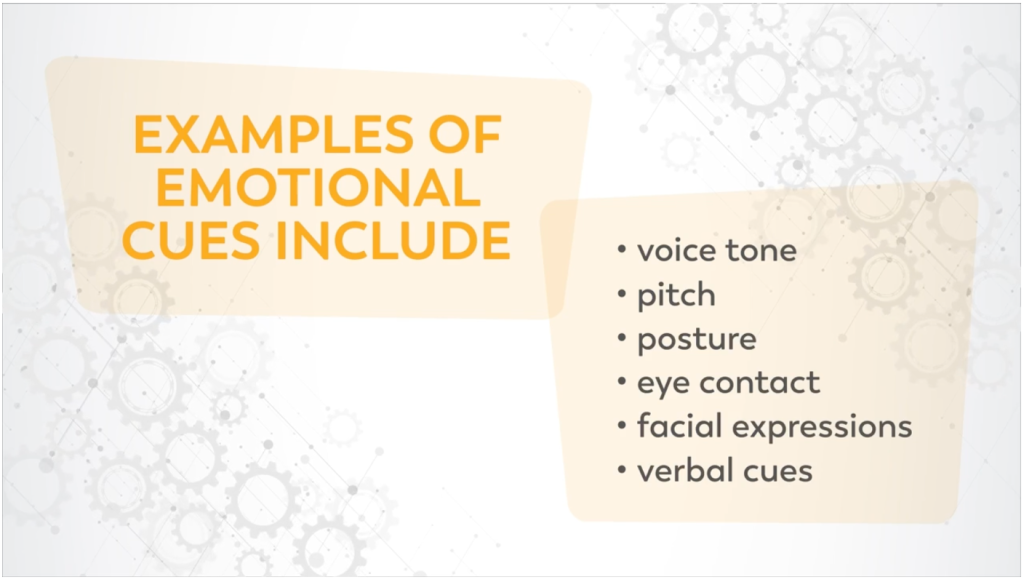Observation is a powerful tool; for leaders, it’s the first step of connecting with their teams. Empathy is the first step to understanding other’s experiences and emotions – or the ability to share someone’s feelings.
What do we mean when we say “increase our emotional vocabulary” and why do we need to do it? Simply put, we’re talking about putting more words to the expansive range of emotions we might experience day-to-day. By increasing our emotional vocabulary, we can more accurately understand what we are feeling in the moment and react accordingly.
A reminder that emotional cues are not just verbal. Other cues to pay attention to include:
- voice tone
- pitch
- posture
- eye contact
- facial expression
- verbal cues
- overall body language

Understanding Empathy
Empathy is simply paying attention to another human being, asking what they are feeling, and committing to understanding their world. When we empathize with others’ viewpoints, we can then navigate a situation effectively.
Nothing is more frustrating or disruptive to finding a solution than having the feeling that you are talking with someone who isn’t listening or truly hearing you. Ignoring the other party’s position only builds frustration and makes it less likely to come to an agreement. The opposite of this is Tactical Empathy.
Tactical Empathy involves deeply understanding and recognizing the emotions and perspectives of the other party. In “Never Split the Difference,” Christopher Voss introduces the concept of tactical empathy as a powerful tool. While empathy is trying to understand a situation from another person’s perspective, one step beyond that is Tactical Empathy.
Understanding the feelings and mindset of another in the moment and also hearing what is behind those feelings allows us to increase our influence in all the moments that follow. It brings our attention to both the emotional obstacles and the potential pathways to agreement. Consider it Emotional Intelligence on steroids!
Remember, Empathy is not about agreeing with the other person; it’s about understanding them. This helps us learn about the position the other person is in but also helps us understand why their actions make sense to them, and what might move them.
4 Key Components of Tactical Empathy
IMPORTANT: Tactical Empathy should be an extension of natural interaction; not an artificial conversation technique.
Let’s go back to our unhappy guest from PART 1 and role-play what our interaction with this guest may look like as an employee using Tactical Empathy…

Guest: Do you know how long I had to wait in line for tickets just now?! I can’t believe how inefficient that was! I don’t have time to be standing around all night. Now I missed half the previews!
Employee: Hello, sir. It seems like you are pretty upset with the amount of time it took you to get your tickets, and that you missed the previews.
Guest: Umm…yes! First there was the issue on Elm Street and then I walk into a long line at your concession stand!
Employee: Issue on Elm Street?
Guest: Yes, they’re doing construction about a quarter mile down the road and it took me 20 minutes to go less than a mile.
Employee: Seems like it’s been a hectic and rather frustrating experience for you. (Pause…)
Guest: (after a second or two) You bet, I specifically took the afternoon off work and all I wanted to do was escape for a couple of hours.
Employee: Well, it seems like you are handling the situation pretty well and I apologize for the long line. I’m going to talk to our team about how we can be better and I appreciate you voicing your concern.
Guest: Well thanks for taking the time to actually ask me about what happened. Most people don’t even listen or care these days. But it still ruined my day. I was really looking forward to seeing this movie and forgetting about the world for a couple of hours. Can I just have my money back?
Employee: I have some good news. We added another showtime this morning and there’s another show in 20 minutes. Why don’t we reserve an ultimate lounger seat for you and in the meantime let’s go over and grab a popcorn at the concession stand. Do you like it with butter? It’s on the house.
Guest: Wow…thanks, yes, that sounds great and I’m happy I’ll get to see the previews. You know this is my go to theatre in Hudson.
Employee: Really? Well that’s great to hear! On your way out, stop by the guest services desk and I’ll have 2 guest passes waiting for you so your next visit is free. We’d love to have you back.
Let’s review this interaction and how the employee deployed Tactical Empathy.
Why Tactical Empathy Works
- Validation: The other person’s feelings are validated, making them feel understood rather than dismissed.
- De-escalation: As humans, it pleases us that the other side is listening and acknowledging the situation. Empathy is a mood enhancer.
- Connection: Empathy allows you to connect and create more meaningful relationships. Finding a solution or a “win-win” is just a bonus.
- Understanding: Tactical Empathy doesn’t demand that you agree with the other person. The goal is to understand the situation from the other’s perspective.
- Identification: Tactical Empathy allows you to identify the emotional obstacles but also the potential pathways to agreement.
In summary, whether you are dealing with an irate customer or a member of your team, you are dealing with someone who wants to be appreciated and understood.
Empathy & Trust
Numerous studies have shown a strong correlation between empathy and trust. When people feel empathy from others, they are more likely to trust and feel positively toward them. Research by psychologists like Carl Rogers emphasizes that…
Numerous studies have shown a strong correlation between empathy and trust. When people feel empathy from others, they are more likely to trust and feel positively toward them. Research by psychologists like Carl Rogers emphasizes that…
Empathetic understanding is a key component of effective communication.
Social Penetration Theory goes further by suggesting that as people engage in deeper and more personal communication, they feel more connected and trusting.
Active listening facilitates this deeper communication by encouraging the speaker to share more personal information, thus strengthening the relationship.
Listening to others often triggers a reciprocal response. If someone feels heard and valued, they are more likely to reciprocate by showing interest and trust in the listener. This creates a positive feedback loop that strengthens the relationship.
Research conducted at Harvard found that talking about oneself, including one’s thoughts and feelings, activates the brain’s reward system. When someone listens attentively, they facilitate this rewarding experience, which in turn makes the speaker feel good about the interaction, leading to increased trust.
Other studies have also shown that nonverbal cues associated with active listening, such as nodding, maintaining eye contact, and leaning forward, are strong predictors of trust. These cues signal that the listener is engaged and empathetic, which helps to build a positive relationship.
If you’ve missed any of the previous installments in this series, you can read them here:
The source material for this article comes from CineTRAIN’s 2-Day Master Class on Team Building. If you’re interested in bringing this dynamic training to your organization (virtually or in person), let’s talk!
